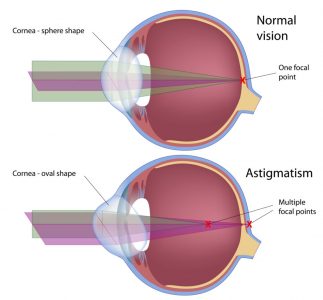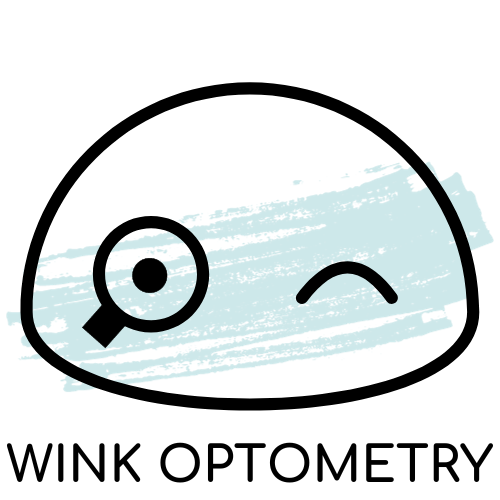Astigmatism – “a defect in the eye or in a lens caused by a deviation from spherical curvature, which results in distorted images, as light rays are prevented from meeting at a common focus”. – definition from Google. It is not entirely wrong but it could use some clarification. This is one of the most common questions I get when patients ask about their prescription. It still boggles my mind that they are unaware when their current glasses have the astigmatism correction in them – their previous eye doctor obviously didn’t explain it to them or tell them they had it. Astigmatism should not be confused with a stigma. Entirely different things but astigmatism is commonly confused for being a stigma. In short, it’s just part of your prescription. Just as you are near-sighted or far-sighted, you can have an astigmatism as well. It’s not a disease and you aren’t unique or odd for having it.
 To better explain it, visualize your eye as an oblong sphere. If you’re near-sighted, the sphere is too long and your natural point of focus is in front of you. If you’re far-sighted, the sphere is too short and the natural point of focus is in virtual space behind the sphere. The front surface for both instances is one even surface. If you combine astigmatism with being near-sighted or far-sighted the front surface becomes more football shaped – meaning that the surface is uneven and has steeper and flatter curvatures. This causes the point of focus to be split in two – so instead of one blurry point, there are two blurry points. The higher the astigmatism the further apart these two focus points are.
To better explain it, visualize your eye as an oblong sphere. If you’re near-sighted, the sphere is too long and your natural point of focus is in front of you. If you’re far-sighted, the sphere is too short and the natural point of focus is in virtual space behind the sphere. The front surface for both instances is one even surface. If you combine astigmatism with being near-sighted or far-sighted the front surface becomes more football shaped – meaning that the surface is uneven and has steeper and flatter curvatures. This causes the point of focus to be split in two – so instead of one blurry point, there are two blurry points. The higher the astigmatism the further apart these two focus points are.
Combining astigmatism with near-sightedness or far-sightedness can give you a variety of different combinations of blurry vision. Both focus points could be in front of you, both could be behind, or one could be behind and one can be in front. Either way, glasses and contacts can correct this. Glasses will always be more accurate and provide sharper vision for those of us with astigmatism due to the fact that they are custom made per prescription. Contact lenses (for the most part) are pre-made and your prescription will fall closer to one than the other. The higher the astigmatism, the more sensitive your eyes will be to deviations from what your prescription should be as well. It is crucial that glasses be made as accurately as possible to prevent eye strain when astigmatism is on the higher end. Aspheric lenses will also provide sharper and less distorted vision for astigmatism correction.

On the extreme end, there is keratoconus which is extreme coning of the cornea to the point where regular glasses and contacts may not be able to correct your vision. For individuals with keratoconus, specialty contact lenses might be required to achieve clearer vision. The coning of the cornea can become quite damaging and end up requiring surgery to prevent the cornea from coning further. Unfortunately, individuals with keratoconus sometimes will not be able to see clearly, but the goal of treatment is to achieve the clearest vision possible that is dependent on how much damage has been done to the cornea.

